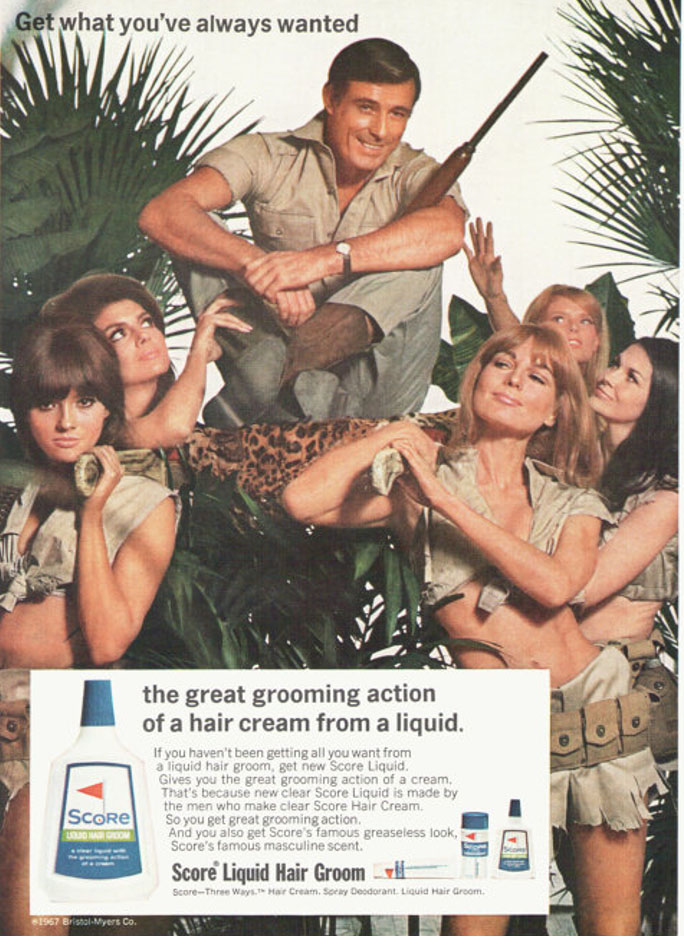How Cultural Ideals change over time . . .
Advertising and Marketing – Score a pre-1970’s advert for male grooming.
SCORE ADVERT

Think about . . . Techniques of Persuasion
- How does this advert create desire for the product
- Think about brand values, brand message, brand personality and brand positioning should inform the analysis
- Think about how and why audience responses to the narrative of this advert may have changed over time
- Essentially, students should be able to demonstrate knowledge and understanding of the persuasive techniques used in the advert
The study of Score can be useful as an analysis of social and cultural change through reference to body image and changes in what society deems acceptable and unacceptable representations (what is radical / reactionary both now and then).
http://areejsmediablog1.blogspot.com/2018/03/advertising-score-case-study-and-wider.html
https://www.campaignlive.co.uk/article/why-brands-need-change-approach-marketing-masculinity/1442291
Some notes on the historical, social and cultural contexts
The Score hair cream advert is an historical artefact from 1967, as such it can be examined productively by considering its historical, social and cultural contexts, particularly as it relates to gender roles, sexuality and the historical context of advertising techniques. 1967 can be seen as a period of slow transformation in western cultures with legislation about and changing attitudes to the role of women – and men – in society, something that the advert can be seen to negotiate.
Similarly, feminist critical thought became much more prominent and pronounced during the counter cultural movements of the late 1960’s and early 1970’s, which heralded, among other changes a greater acceptance of birth control and divorce, abortion and homosexuality.
There was also the abolition of hanging and theatre censorship, and the Obscene Publications Act (1959) which led to the Chatterly trial. Nevertheless, as Johnathon Dollimore wrote: ‘all this should not be seen as a straightforward displacement of dominant conservative attitudes‘ (1983:59).
However, the Score advert was produced in the year of decriminilasiation of homosexuality and as such, the representation of heterosexuality could be read as signaling more anxiety than might first appear. The reference to colonialist values can also be linked to social and cultural contexts of the ending of Empire (see this link).
The advertising techniques of fifty years could be compared to those of today. For example, references could be made with the Lynx Effect advert and the Specsavers adverts (both from 2010) which received criticism from the ASA, read this link or this link. And again reference to body image and changes in what society deems acceptable and unacceptable representations. So have ideas and acceptance around representation of gender really changed since the 1960’s?
AN ANALYSIS OF SCORE
• This text was chosen for its jaded sexist almost bravado (feeble manifestations of both patriarchy and colonialism).
• Of course this is isn’t the only reading and could be seen as simplistic and ‘tongue-in-cheek’: the jungle is clearly a constructed set and the Big Game Hunter/colonial adventurer a cartoon character.
• References to these stereotypes are delivered through costume and props with the ‘hero’ carried shoulder high but not as a ‘trophy’ (the trophies are below).
• There is an unconvincing sexual power also here anchored by the copy: “If you’re not getting what you want from your hair cream”: costumes ‘display’ these relationships.
• All of this frames the most significant (historical, social and cultural) story: a snapshot of historical values (colonialism) in the teeth of the social and cultural revolution of the 1960s: it has never been other than (partly) ironic.
• Though this simplification might be its greatest weapon since it makes the past a harmless cartoon and hard to get hold of (Barthes said myth was an alibi which always has an elsewhere at its disposal: his semiology was to be a study of how stereotypes are made).
• The advert is socially/historically relevant in terms of the conversation it now engenders between the context of its production (1967) and of its current reception (2022).
A written response
A detailed study of Score should enable students to develop an understanding of the dynamic and changing relationships between media forms, products and audiences, expressed over time through changing representational values.
Analysis could include:
- How does Score construct a narrative which appeals to its target audience – think about Character and Narrative Structure
- Semiotics: what signs are being used and how are they being used? Remember this post on Semiotics. So try to use some of this key language: Sign, Code, Convention, Dominant Signifier,, Anchorage. Ferdinand de Saussure: Signifier, Signified. C S Pierce: Icon, Index, Symbol. Roland Barthes: Signifcation, Denotation, Connotation, Myth, Ideology, radical, reactionary, Paradigm, Syntagm
- Representational Analysis: How are groups individuals and ideas represented remember that these are socially and historically relative, BUT they do incorporate viewpoints and ideologies which need to interrogated. So think about the decisions and choices that have been made about how to represent social groups. Try to apply some of the key words and ideas that we looked at before eg David Gauntlet key terms:
- Fluidity of identity
- Constructed identity
- Negotiated identity
- Collective identity
And some of these other key terms: Male gaze, Voyeurism, Patriarchy, Positive and negative stereotypes, Counter-types ,Misrepresentation, Selective representation, Dominant ideology, Constructed reality, Hegemony, Audience positioning etc etc

